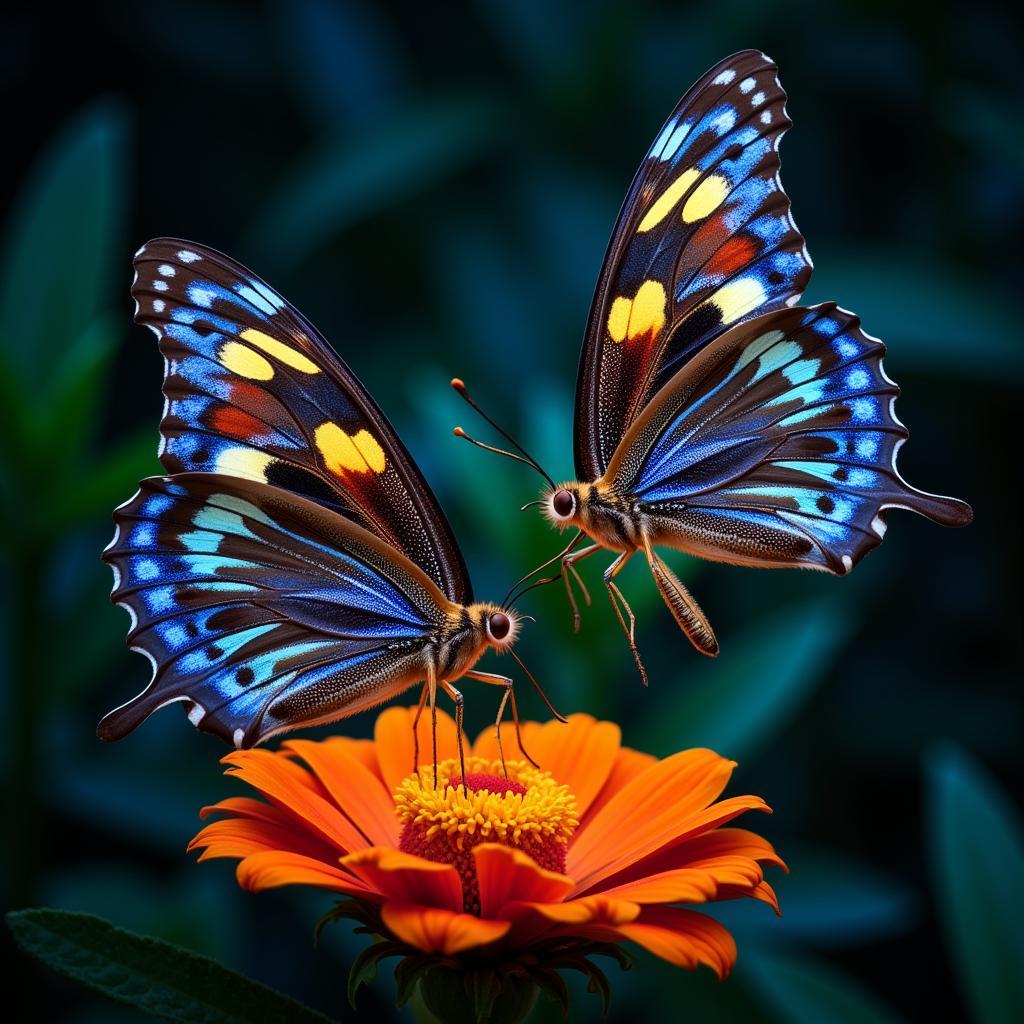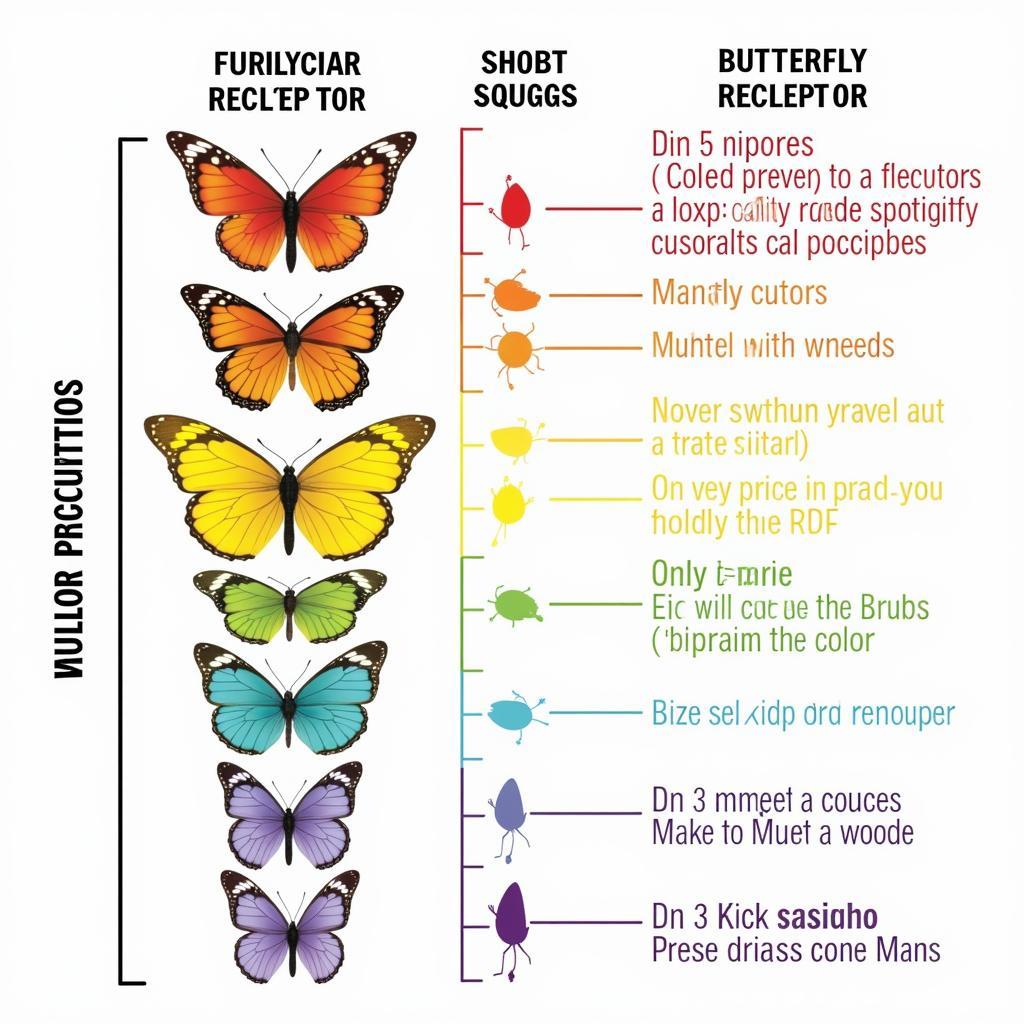Butterflies, with their vibrant wings and fluttering flight, inhabit a world of color far richer than our own. Their vision, a complex interplay of ultraviolet light and a broader spectrum of colors, allows them to perceive a world unseen by the human eye. What colors do butterflies see, and how does this impact their lives? Let’s delve into the fascinating world of butterfly vision.
Similar to how we perceive color, butterflies have specialized photoreceptor cells in their eyes called cones. These cones are sensitive to different wavelengths of light, allowing them to see a range of colors. However, unlike humans who have three types of cones (red, green, and blue), butterflies can have up to nine, significantly expanding their color perception. This broader spectrum extends into the ultraviolet range, invisible to us.
How Does Ultraviolet Vision Benefit Butterflies?
Ultraviolet light plays a crucial role in the lives of butterflies. They use it for a variety of purposes, including finding food, identifying mates, and navigating their environment. Many flowers have ultraviolet patterns, invisible to us but acting as beacons for butterflies, guiding them to nectar sources. These patterns, known as nectar guides, act as landing strips for the insects, facilitating pollination.
 Butterfly using UV vision to locate nectar guides on flowers
Butterfly using UV vision to locate nectar guides on flowers
Furthermore, butterflies use ultraviolet vision to distinguish between potential mates. Male and female butterflies often have different ultraviolet markings on their wings, aiding in species recognition and mate selection. These markings, invisible to predators, provide a secret language of love within the butterfly world.
The Butterfly Color Palette: Beyond Ultraviolet
While ultraviolet vision is a key aspect of butterfly sight, their perception of other colors also differs from ours. They can see a wider range of colors, including those we perceive as red, green, blue, and even shades we can’t even imagine. For instance, they can see polarized light, which helps them navigate even on cloudy days. Think of it as having a built-in GPS system based on the sun’s position. This ability, combined with their broader color spectrum, creates a vastly different visual experience. They might see a flower we perceive as yellow as a kaleidoscope of hues, thanks to their ability to distinguish subtle variations in color. Just like how what color are butterflies explores the various hues of butterfly wings, understanding their vision allows us to appreciate the hidden beauty they experience.
What Colors Do Butterflies Not See?
While butterflies have a richer color experience than humans, their vision isn’t perfect. They may have limited sensitivity to certain colors at the far ends of the spectrum, particularly in the red range. However, this limitation is often compensated by their heightened sensitivity to other colors, such as ultraviolet. This is similar to how some humans experience color blindness, where the inability to see certain colors is compensated by heightened sensitivity to others. You might be interested in exploring the diverse colors of geraniums, which are attractive to many pollinators including butterflies, in our article what colors do geraniums come in.
Do All Butterflies See the Same Colors?
Not all butterflies see the same way. Variations in the number and types of photoreceptors can lead to differences in color perception between species. Some species are more sensitive to certain colors than others, depending on their ecological needs and the flowers they frequent. This diversity in visual perception highlights the intricate relationship between butterflies and their environment.
 Comparison of color vision across different butterfly species
Comparison of color vision across different butterfly species
How Do Scientists Study Butterfly Vision?
Scientists employ various techniques to study butterfly vision. Behavioral experiments, electrophysiology, and spectral analysis are used to understand how butterflies perceive color and how this influences their behavior. These studies continue to unveil the fascinating complexities of butterfly vision and its role in their survival. Just as we explore the meaning behind the diverse colors of roses in what does the different color roses mean, scientists delve into the world of butterfly color perception to uncover the intricate relationship between color and behavior. For a fascinating look into the color vision of another insect, check out our article on do flies see color.
In conclusion, butterflies see a world of color far beyond our own limited perception. Their ability to see ultraviolet light and a broader spectrum of colors plays a crucial role in their lives, from finding food and mates to navigating their environment. This hidden world of color offers a glimpse into the remarkable sensory adaptations of these beautiful creatures. Understanding what colors butterflies see helps us appreciate the intricate beauty and complexity of the natural world.
FAQ
- What is the main difference between human and butterfly vision? Butterflies can see ultraviolet light and a wider range of colors than humans.
- Why is ultraviolet vision important for butterflies? It helps them find food, attract mates, and navigate.
- Do all butterflies see the same colors? No, there are variations in color perception between species.
- How do scientists study butterfly vision? They use behavioral experiments, electrophysiology, and spectral analysis.
- What colors are most attractive to butterflies? Butterflies are often attracted to bright colors, especially those with ultraviolet patterns.
Need help with color selection for your home or business? Contact us at Phone: 0373298888, Email: [email protected], or visit us at 86 Cầu Giấy, Hanoi. We have a 24/7 customer service team ready to assist you. Are you interested in learning more about color theory and its application in design? Check out our other articles on our website about complementary colors like purple and yellow: are purple and yellow complementary colors.

